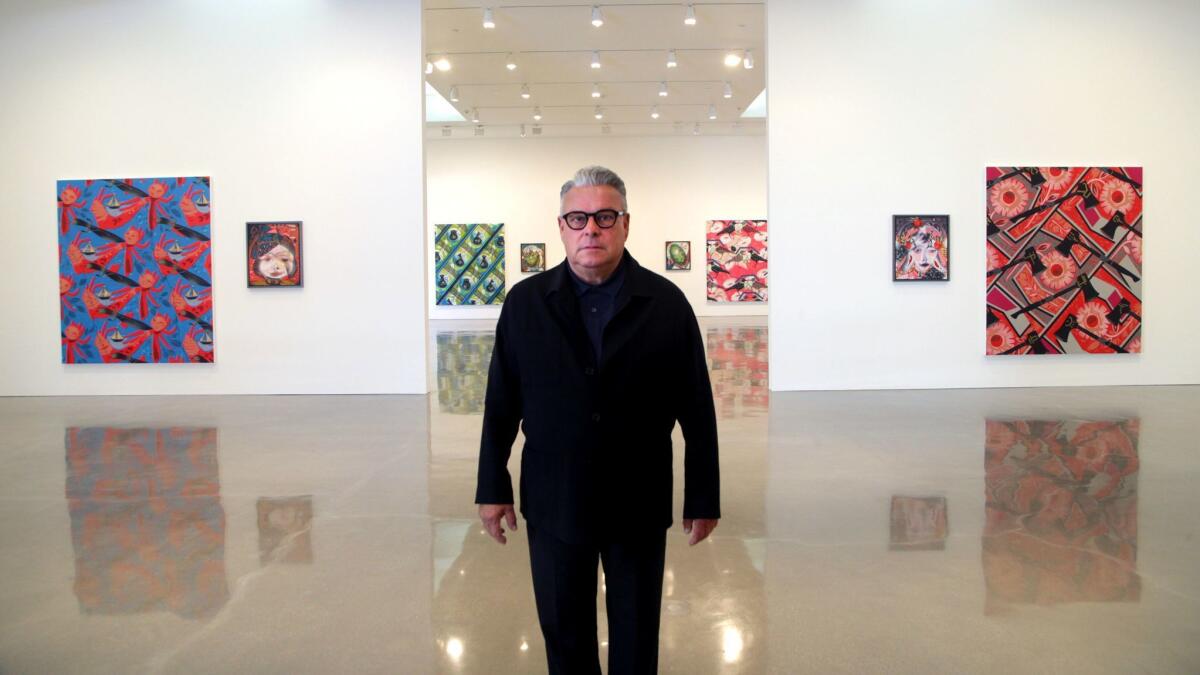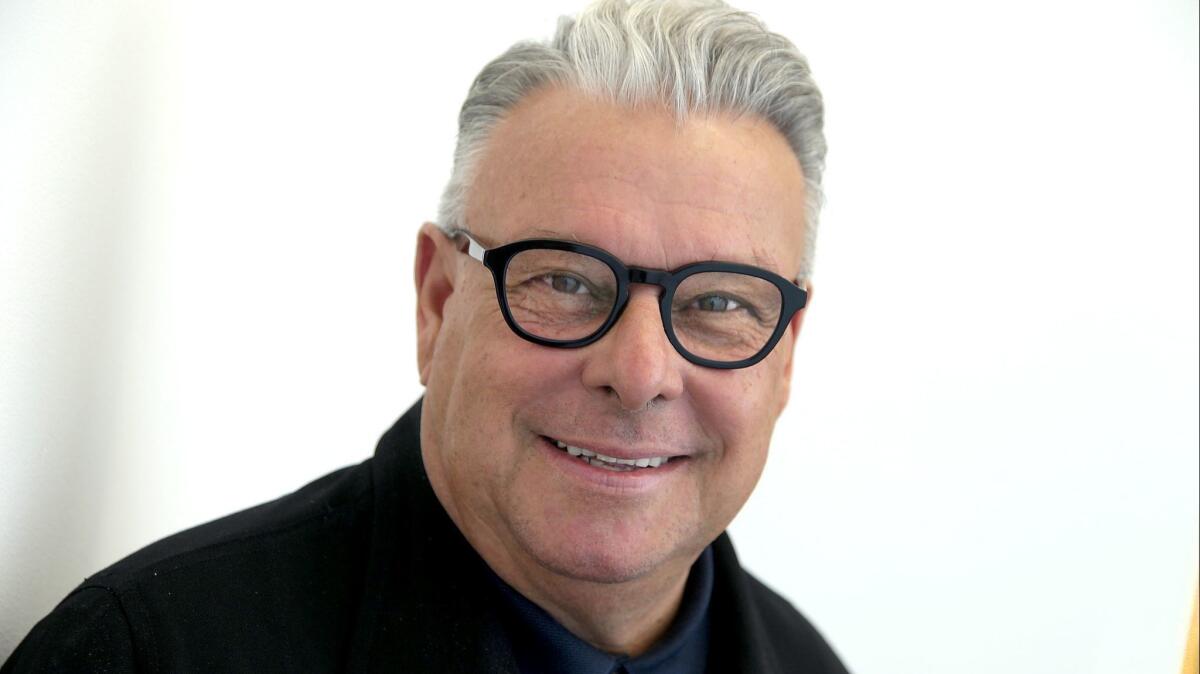In conversation: Painter Lari Pittman finds beauty in violence and telenovelas. He also has advice for MOCA

In the 14th century, if you had donned a striped shirt and walked the lanes of a medieval French town, chances are you might have been assaulted or even put to death. Stripes, in those days, were pretty much considered the fashion of the devil — the sort of motif associated with prostitutes and Catholic cults.
It’s hard to know what violent acts those Frenchmen might have resorted to if you had sported a brocade pattern featuring images of hand axes or a chintz design bearing daggers. After all, what kind of outcast would show up in public in an ensemble covered in knives?
It is that very question that Lari Pittman imagines in a series of new paintings at Hollywood’s Regen Projects. “Portraits of Textiles & Portraits of Humans” pairs a large canvas inspired by textile design (a long-running theme in his work), with a smaller “portrait” of a figure visually linked with that design.
“I wanted to create a fictive and conjectural relationship through the lens of the decorative arts of what humans might look like paired with a textile — and ask the viewer to create a relationship between the two,” Pittman says. “What culture would want to produce a textile with ominous axes on them?”
Over four decades, Pittman has created deeply layered paintings, often in buoyant color palettes and inspired by the applied arts. In these, he has touched on the wide range of human emotion, such as mortality, power and the vagaries of sex and desire, namely, the homoerotic kind.
Plus, there have been his ruminations on trauma, illness and death. During his life — Pittman is 67 — he and his paintings have borne witness to the ravages of the AIDS epidemic and his own near-death experience: In 1985, the Los Angeles artist survived being shot in the stomach during a home invasion.
While his subjects can be dark, Pittman is anything but — commenting with dark humor that the shooting made him “an even stronger atheist.”
I want the viewer to be a little more conflicted in the relationship between the abject and the sublime.
— Lari Pittman
Pittman, the son of a U.S. father and a Colombian mother (he is is fluent in Spanish), has since the 1980s been an important face of L.A. art. His work resides in the permanent collections of the Museum of Modern Art, the Art Institute of Chicago and the Los Angeles County Museum of Art. Currently he is at work on a career retrospective that will make its debut at the Hammer Museum next fall.
The artist has made headlines for other reasons too: In February, he publicly resigned from the board of trustees of the Museum of Contemporary Art Los Angeles (where his work is also held), telling The Times’ Deborah Vankin that the museum had “a vision problem.”
In this lightly edited conversation, he discusses how his love of textiles continues to inspire his work, what he finds compelling about telenovelas and, for his former colleagues at MOCA, he offers a little advice.
How do you create these invented textiles? What sources do you use for research?
I recoil against the word “research.” I think it’s a term that’s become a retail term within the art world. But I have always looked at textiles. I study the textile work of Sonia Delaunay, who I think was much more important than her husband [Robert Delaunay], who got the bigger page in art history. There is Natalia Goncharova, who I think responded to the Russian Revolution not only with her beautiful paintings, but through costume design, theater design and folkloric impulses.
I also love that period of textile design called Festival of Britain, after World War II. It was this incredible moment when all types of designers created a kind of positivity after the trauma of World War II. Plus, [my husband, artist] Roy [Dowell] and I have a really large collection of Mexican textiles. Those are always a reference point. I love that strange moment when folklorism and Modernism come together in a weird combination.
Color certainly seems to play an important role in your work.
I think of Diana Vreeland’s amazing quote that “pink is the navy blue of India.” It says so much about what color is valued over another. When I was a young person working in the design world, the saying was, “Where there is taupe, there is hope.” I reverse that and I say, “Where there is taupe, there is no hope.”
Color for me is also political. I’m always very interested when you read in the newspaper that there is an uproar in a neighborhood because someone has painted their house purple. Almost every year, an article surfaces about someone painting their house purple. Color is very powerful.
Your paintings often render violence or objects of violence in beautiful ways. Why make it more sublime than abject?
Although I’m an atheist, I look at the history of Western European religious painting and I ask, “What do they do really well?” And I think it’s that they are able to exacerbate and make more palatable the violence of its own history and iconography by aestheticizing it and not making it abject. Aestheticized violence is actually more disturbing. Quentin Tarantino might do it. Certainly Pedro Almodovar does it. [Italian director Luchino] Visconti did it.
It’s interesting how Catholicism was very, very deft at organizing representations of violence while wearing the garments of the sublime.
What about desire? In the era of the #MeToo movement and the Brett Kavanaugh hearings, the news has made sex feel really abject.
This may be more personal: I grew up my entire life with the cultural response to homosexuality as abject. Why would I want to incorporate that into my work? Why would I embrace that? As a young artist I made a really clear decision that that was a line drawn in the sand. The flirting with the representation of the abject was the privilege of straight people.
If I’m going to make art about it, how do I fix it up? How do I create more of a discussion of the bittersweet? That’s the register I love: The bittersweet — it sets up this simultaneity of contradictory feelings. If you squarely represent the abject, the expected response to it, it’s so specific. I want the viewer to be a little more conflicted in the relationship between the abject and the sublime.
If I am a devotee of any altar, I’m a devotee of Pedro Almodóvar. He sets up that bittersweet aspect of human nature. I study him very closely. I also find that I’m a bit obsessed with the telenovelas coming out of Spain on Netflix.
Which telenovelas?
I’ve been watching “Velvet,” which takes place in Franco-era Madrid. It’s centered around this fashion house called Velvet and the making of bows. There’s another one I saw that came out of Colombia that has to do with the history of slavery in Colombia that takes place in the [early 19th century] called “La esclava blanca” [“The White Slave”].
At the very core are these cheesy love stories and it always centers on love and class struggle. There is always this point where the mother of the house yells to the lower-class protagonist, “You have ruined our family’s name. ¡Lárgate de aquí!” [Get away from here!]
But going back to the bittersweet, I look for it. And I’ve consistently found it in Almodóvar and in these telenovelas, which set up a protocol for talking about it.

What’s it been like to survey your life’s work in preparation for next year’s Hammer retrospective?
It’s shocking in that it’s 40 years’ worth of work! It’s a thrilling exercise to forensically reconstruct a body of work. But it doesn’t come without its anxieties when you are going backwards. I’ve always been proud of my work. That doesn’t mean I’m not hyper-critical of it. I’m suspicious of artists who are not hard on their work. When Lindsay Lohan says she doesn’t regret anything in her life, I’m, like, “I’d like to be Lindsay Lohan.”
I would say that I’m very aware that the most treacherous unraveling of artists tends to be in the mid- and advanced career. I’ve always been very watchful of that. I’ve done very well in the art world and I’m grateful for it. At the same time I’m not interested in redundancy in my work. After every body of work, I actually put up Post-it notes of things I can’t do — at least for a while.
For example, I did a show in Berlin two years ago that was all grisaille — almost no color or very little color except red, black and white. And I’d done a show called “Nuevos Caprichos” at Barbara Gladstone and it centered around the psychologically and physically traumatized body, so I said, “Let’s move away from that.” Those are some of the things that I wrote down.
Instead, I thought I’d concentrate on a strange malevolent jouissance.
MOCA recently named MoMA’s Klaus Biesenbach as director. What advice can you offer him and the board moving forward?
I have two voices as a way of answering. My queen-y voice would say, “I wish them well.” My more serious voice says that the reason why so many of us remain so agitated and grouchy about MOCA is because we love it. We have expectations for it and because of it.
My advice: Make artists your most important constituency. Artists are some of the most educated and refined Americans. Why wouldn’t you want them as your No. 1 constituency at the Museum of Contemporary Art?
What audience would you say MOCA is aiming for now?
The constituency is 90210.
Lari Pittman: ‘Portraits of Textile & Portraits of Humans’
Where: Regen Projects, 6750 Santa Monica Blvd., Hollywood
When: Through Oct. 25
Info: regenprojects.com
ALSO
Want to see Lari Pittman paintings without crowds and blocked views? Go to this box in Culver City
When More Really Is More: Lari Pittman’s mid-career retrospective at LACMA
More to Read
The biggest entertainment stories
Get our big stories about Hollywood, film, television, music, arts, culture and more right in your inbox as soon as they publish.
You may occasionally receive promotional content from the Los Angeles Times.











